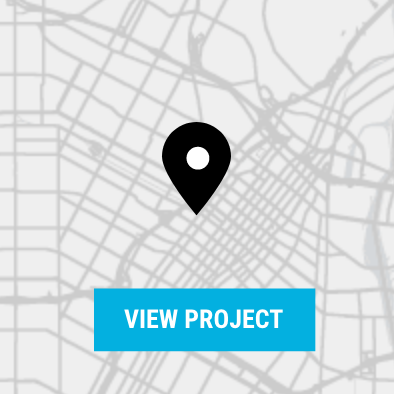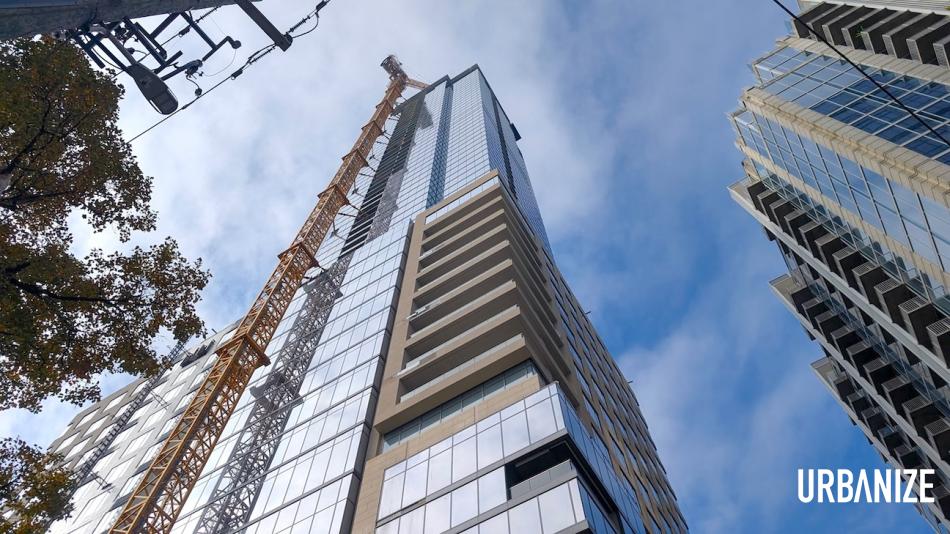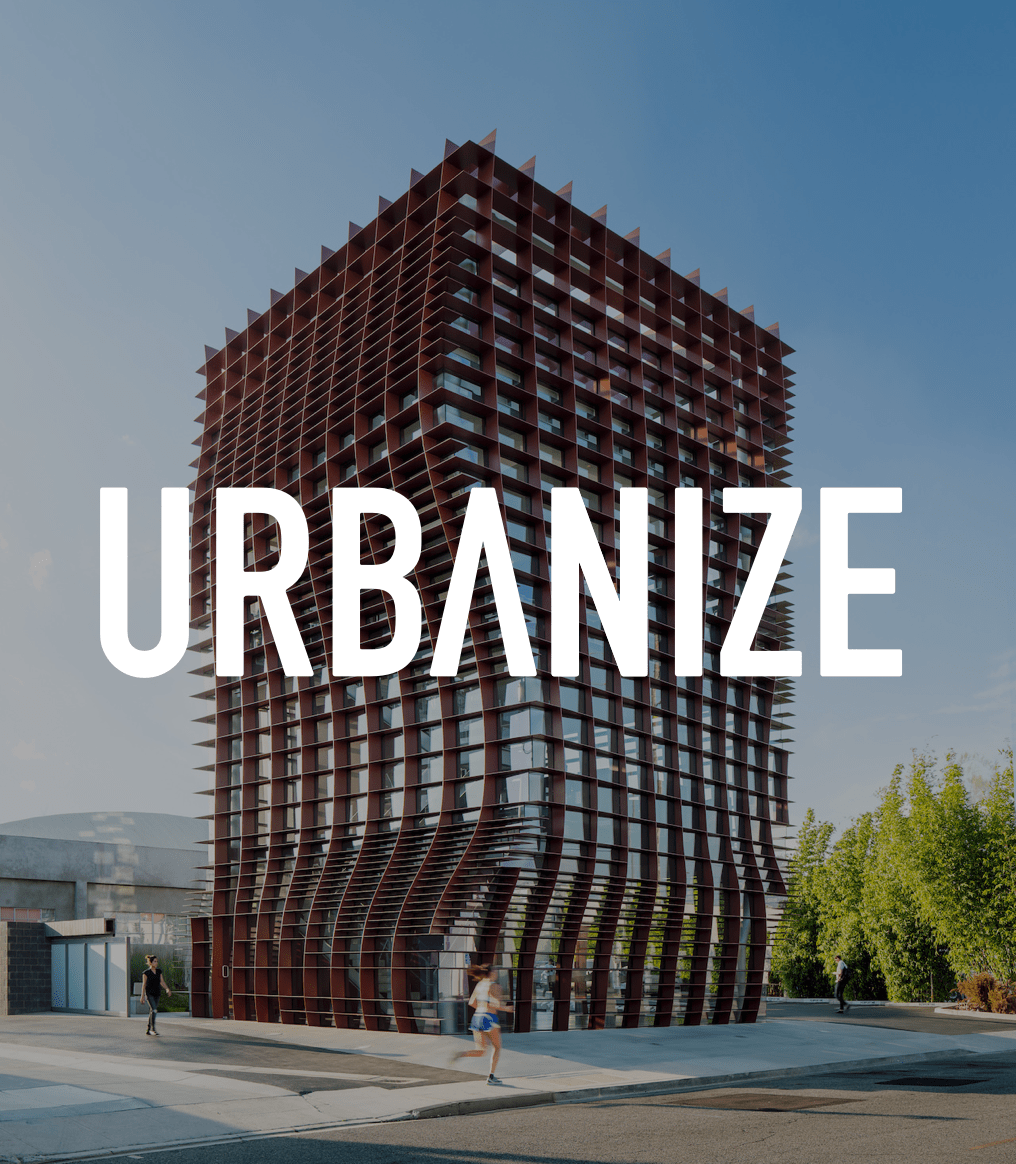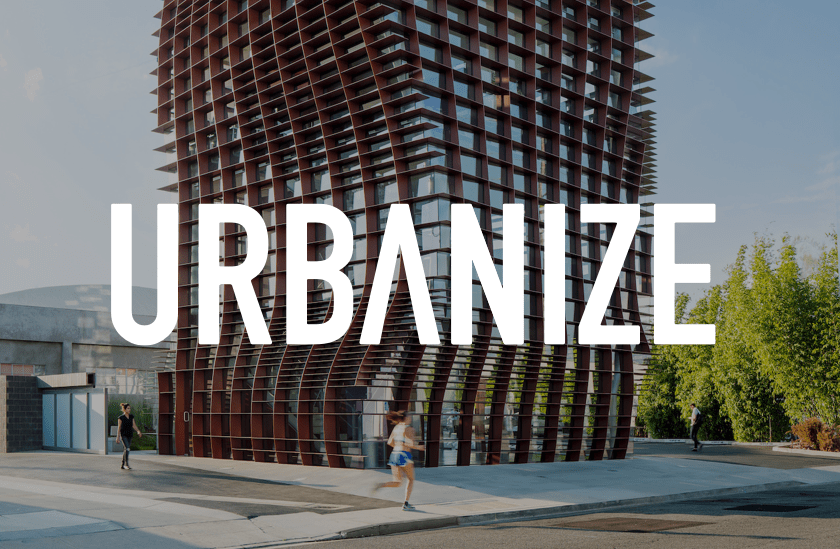“This is an Atlanta building. It’s all designed, engineered, and built by locals. The city deserves it.”
So says John Petricola, the Southeast senior managing director of New York City-based Rockefeller Group, in reference to his company’s 1072 West Peachtree project. In terms of sheer height, it dwarfs any tower built in Atlanta for 30 years, and it represents Rockefeller’s biggest bet on the city where it chose to stake its Southeastern headquarters more than a decade ago.
Construction crews installed the final beam atop the 60-story, 749-foot-tall sky-rise a week ago. With the fanfare and literal dust on that event now settled, Petricola had time this week for a wide-ranging, candid, and in-depth interview with Urbanize Atlanta.
The Rockefeller employee of 20 years has made innumerable trips to Atlanta, and below he lends a preview of what Midtown’s newest true skyscraper will bring, while also discussing the outlook for developing on a monumental scale again and broader topics such as Atlanta’s place among Sunbelt competitors.
Next year, 1072 West Peachtree is set to debut 357 upscale apartments, eight floors (224,000 square feet) of office space, a full acre of indoor and outdoor amenities, and 6,300 square feet of retail at street level.
The following Q&A has been lightly edited for clarity and length.
...
Urbanize Atlanta: We’ve been writing about development trends in Atlanta for years, and this is obviously a one-of-one project, at least from a height perspective. What made you and Rockefeller confident the Atlanta market was ready for this, right now?
John Petricola: Nobody can predict the future. But we did see some evolution taking place through Atlanta, through the activity of other projects and peer developers. Some of the activity, you’d probably give some kudos and credit to Georgia Tech—when they jumped the [Connector] highway, if you will. When Tech Square was envisioned by them, and there was a spark of development that was primarily focused on tech-related companies. When that was initiated, we were definitely watching that closely, and seeing that was the start of momentum of tech-related jobs. And jobs coming into urban centers sometimes also attract residential demand.
We definitely saw that happening well before COVID, when some of that development started moving north from Tech Square. You could see the office demand absorption was kicking off. [It’s] that kind of environment where people want to live and work. So that started building up our confidence level that if we could find a site that could draft off of that a little bit, take advantage of that momentum coming our way, then let’s go do it.
UA: What stood out about the site?
JP: That site in particular—1072 West Peachtree [Street]—had some unique qualities that a lot of other sites we’d looked at and just never got confident with [lacked]. That particular site being on 12th Street—that’s a key street for us. It has kind of a direction shot all the way to Piedmont Park. It is a two-way street.
Being on that corner really allowed us to be able to take advantage of northbound traffic on West Peachtree [Street] and then capturing the need to go southbound on Spring [Street]. If we could design a project that worked, you’d have the ability to get in and out of it very efficiently. And we knew that was a real driver for office demand. If the jobs are there, then knock on wood that hopefully the residential demand will be there.
The 749-foot-tall building was constructed by Atlanta-based Turner and designed by TVS, in collaboration with Brock Hudgins Architects. Courtesy of Rockefeller Group
UA: Everyone’s aware of your partnership with Selig, at the three-tower development across the street. But it sounds like you’ve had your eye on Atlanta for longer than that?
JP: Our partnership with Selig, that was our baby-step into Midtown. Just for historic background, I opened our office for the Southeast in Atlanta in 2013, so we’ve been in Atlanta with an employment presence. Most of our team—14-plus people—live in Atlanta, are in our office in Buckhead, and have been focused on Southeast regional development activity.
UA: Did you live here, or commute?
JP: The entire [Southeast office] team does, but I commute throughout the entire Southeast. I actually commute in from Miami.
UA: As someone who’s spent a considerable amount of time here, do you think Atlanta stands out among its growing, Sunbelt peers in any way?
JP: I do. And speaking for the company, we as an organization specifically chose Atlanta for our Southeast hub. Before that, our Southeast hub was based out of Miami. In order to really kind of dive in and be part of the whole Southeast picture… we chose to plant our flag in Atlanta over other Sunbelt cities.
We have projects and investments in other cities such as Charlotte, and we’re a big fan of those cities, but Atlanta I think punches above its weight in a lot of aspects. A lot of it I think is the strength of the population, as in educated strength, diversity strength. A lot of [corporate headquarters]. Cost of living is reasonable. Highly educated workforce. There’s a lot of things that Atlanta has been able to achieve, broadly throughout multiple industries as well… It’s not just tech-focused, or financial. Somebody might accuse Charlotte of being too financially focused, from fintech or financially bank-based companies. But Atlanta, as a way to compare, seems to have much more of a broad industrial base, from Coca-Cola to Home Depot and different types of industries… [That] makes it a resilient city from our point of view that allows for this level of development.
UA: Does Atlanta’s mass transit—particularly MARTA rail—make it stand out in Rockefeller’s eyes?
JP: Absolutely. Our ability to get comfortable with 1072 West Peachtree, a big part of the thesis is that we were approximately 10 minutes walking distance to two MARTA stations. As cities get more congested quite frankly—and Atlanta’s definitely one of those cities—having the ability to have public transportation opportunities helps.
You know, we’ve had many, many conversations over the years with a lot of architectural and engineering firms based in Atlanta who specifically used MARTA for their international travel, for companies that come in. The Atlanta airport, as you’re aware, is one of the few that has a station on the airport. There’s a lot of cities, I’m sure, that are quite jealous of that. From there into Midtown, it’s 20 minutes—like clockwork. That airport has no peer.
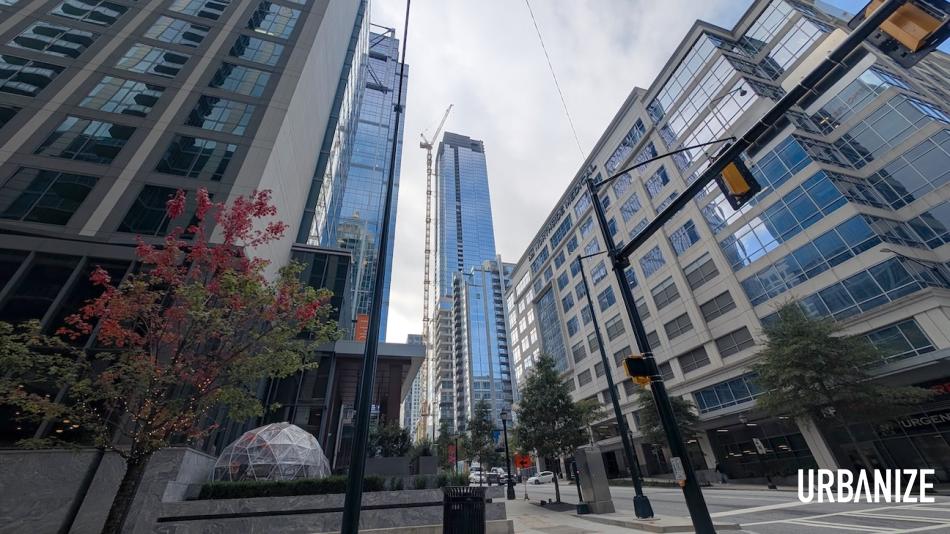 Moments after the final beam was installed, a southward look at the 1072 West Peachtree high-rise Nov. 7 from West Peachtree Street. Josh Green/Urbanize Atlanta
Moments after the final beam was installed, a southward look at the 1072 West Peachtree high-rise Nov. 7 from West Peachtree Street. Josh Green/Urbanize Atlanta
UA: A recent guest in town from north of Denver was astounded by the amount of young people she saw here. “Unbelievably vibrant” is the phrase she used. It sounds like that also played into what you saw as an attribute.
JP: I think you see maybe 20, 30 years ago the leadership of offices may have chosen other submarkets [in metro Atlanta]. But now you’re kind of chasing your potential employee. So where do the employees want to live and work? And the decision-makers of those offices are saying maybe we should look at opportunities in Old Fourth Ward or Midtown proper or West Midtown. We’re definitely chasing that same thing.
UA: I saw that Rockefeller is hiring a real estate development analyst in Atlanta. Maybe that’s standard protocol, or maybe you’ve grown more confident in Atlanta throughout the 1072 West Peachtree process? So when’s the next tower coming?
JP: [Laughs]. That’s a tough one. These opportunities to build projects like this are pretty rare, getting all the puzzle pieces in place, especially lining up not only the development team but the capital. That window’s only open at certain times of the real estate cycle. So we should all count ourselves lucky if you’re there when the window’s open, and you can get a job done like that.
That’s not to say we would never do [a high-rise] again, but it’s a few moments of serendipity that allowed us to get this one where it is. If we’re not doing a tower, that doesn’t mean we’re not still actively engaged in trying to do development throughout Georgia and the Southeast.
UA: Any idea what 1072 West Peachtree is going to end up costing, as an investment?
JP: We tend not to release formal numbers like that. But you could probably do some backend math and realize it’s not a cheap project.
UA: Shifting to the project itself, a lot’s been said and written about these being the highest homes in the history of Atlanta, which has no shortage of tall buildings. The view across the city from up there, as a selling point, how is that going to be?
JP: For timing’s sake, we’re going to be formally in the market early next year, the first quarter. So we have yet to release that marketing process. But early indications from our property managers, our team, [is that] it’s going to be an exciting opportunity to live at that level. Being in the penthouse in a 40-story building down the street… great views, and really high rents. Our lower residential floors start around 20 or 21, going up to 60. So we literally have a 40-story tower sitting on top of a 20-story podium. The opportunity—a lot of people haven’t experienced that, because there are very few comparable buildings.
We’re excited to get people in the building. It’s one of those things when you’re looking out into the city—well into downtown, well into Centennial Yards—the view is unbelievable. You can see Stone Mountain clearly—clear as day.
Just another thesis here: Not everybody who will live in that building may be in the City of Atlanta right now. We’re building for the future; as the city grows and attracts new businesses and people from around the world, they might be more comfortable in a high-rise like that, and that’s part of the opportunity.
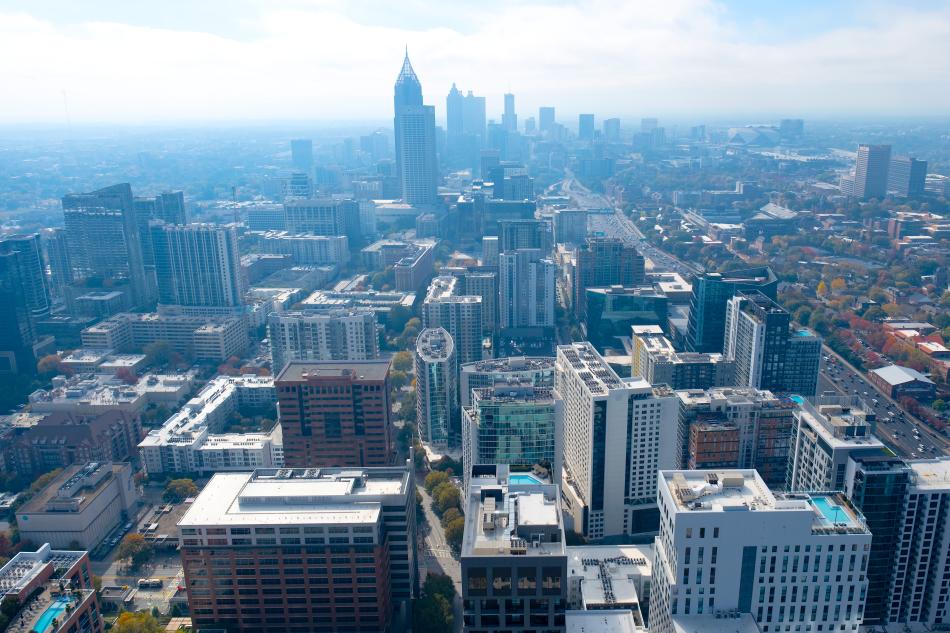 View south toward downtown from 1072 West Peachtree's highest floors today. Courtesy of Rockefeller Group
View south toward downtown from 1072 West Peachtree's highest floors today. Courtesy of Rockefeller Group
UA: It’s topped out, in terms of the final beam, but not completely finished at top. Renderings show what you might describe as decorative fins. Can you paint the picture about what’s left to come with the top of the building?
JP: You can see now the two-story mechanical room of the elevators [on the roof]. The intent is that you will never see that in the future. So we still have to build our parapet wall around that, which will have the ability to be lit appropriately and be part of the skyline. That’s going to be a big kind of reveal.
UA: Standout, unique lighting for the structure—sounds like that’s a priority?
JP: Yes, we want to make sure it’s lit appropriately and a part of the skyline. It’s going to have an appropriate parapet that’s beautiful. We’re still holding on to what exactly that delivery will be. So stay tuned.
UA: Especially online, everyone’s an architecture critic, but some have expressed opinions the building is a little too understated, especially juxtaposed with the decades-old icons of Atlanta’s skyline. Or people think it’s a sleek contrast to that. Was there any specific logic to the design?
JP: There was. And we spent quite a lot of time with TVS [architects], designing the different types of buildings that could fit on that site. There was a lot of discussion around how iconic it could be within the context of all the other constraints you have. And frankly, budget constraints are always a big part of these conversations, especially in today’s world.
So it wasn’t that we were not paying attention to trying to create an icon, but we were also trying to make sure we had a project that would perform well, which is a part of the conversation that a lot of developers don’t always expose, because a lot of people see what is the end result, but you’re also trying to make sure the market absorbs your product. Are your floorplates efficient? Is it easy to manage the trash in the back of the house? We probably spent—I hate to say it—probably months working on the truck dock… making sure the trash can be collected so that you’re not seeing trucks backing to a side of the building, dealing with trash early in the morning. Things like that.
You experience buildings like this in different ways. When someone makes a comment about it, it depends maybe on the context in which they experience it. If you are driving down the Connector, you’re definitely seeing the backside of it from a different perspective. I suspect there are so many people stuck on the Connector at 4 o’clock, just staring at it, and you form opinions. But when you’re standing at the corner of 12th and West Peachtree, looking up, and you’re just like, “Wow, that’s a whole unique experience in a different way.” I hope, over time, as people kind of get to know the building, and the building becomes part of the fabric of the city, people will have different views. That it’ll evolve. Try not to read too many of those comments, though. I’ve read a few. I kind of laughed, but it’s good though.
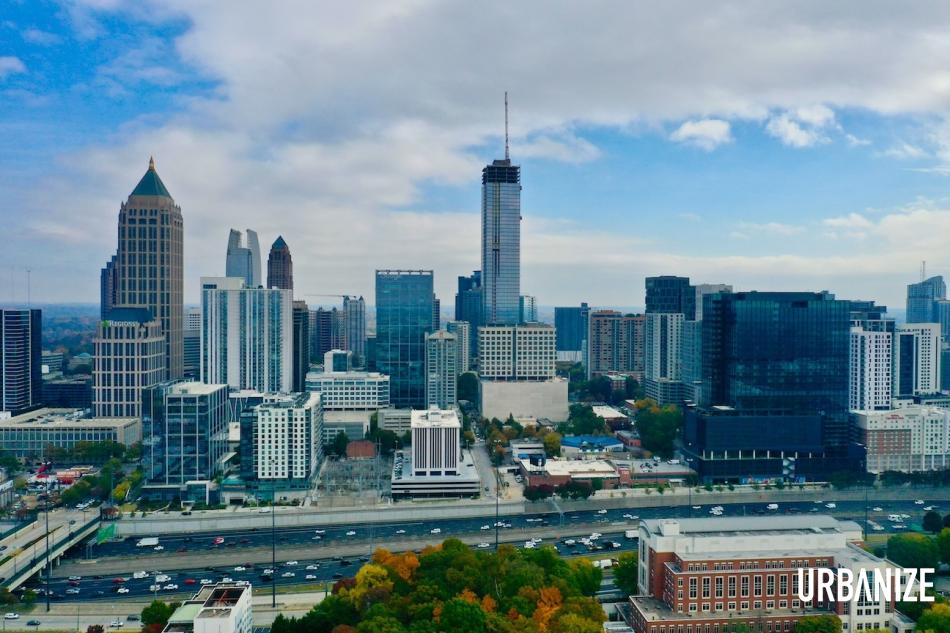 View of the 60-story skyscraper in relation to Atlanta's downtown Connector expressway. Josh Green/Urbanize Atlanta
View of the 60-story skyscraper in relation to Atlanta's downtown Connector expressway. Josh Green/Urbanize Atlanta
UA: To what you were saying earlier, it’s a risky bet on office at this point, even the most highly amenitized stuff. At what point will you consider this project a success?
JP: Our success is when that project gets absorbed, when tenants see what we see and actively start signing leases. We’re tracking very similarly to other office buildings, where it takes the building to be built for a little bit to generate traffic, tours. Atlanta’s definitely a “show me” city. A lot of people aren’t signing big preleases on pretty pictures.
Without a doubt, office is a quickly evolving kind of property use, especially post-COVID. We’re looking at how this return-to-office is evolving and how you attract tenants with amenities… West Peachtree [Street] has a new bike lane coming in, so just the ability to get to and from the building in an experience like that [is a focus]. We’re seeing, knock on wood, through our other colleagues say at 1020 Spring, absorption is happening in Midtown, that flight to quality. We hope to be part of the same thing. It’s not a very large office project in relation. That gives us some confidence we won’t have too much problem in absorbing it.
UA: On the residential side, I know it’s early and preleasing hasn’t started yet. But any idea what it will cost—let’s say, at minimum—to live there?
JP: We’re going to be in the same range as other premium apartment communities that have opened in Midtown. That’s probably the best way to gauge it. I’d hate to give you ranges now and be so far off. The reality of it, in order to make these projects work, these will be premium rents… We’re trying to target a specific renter group. That renter group is a renter-by-choice [demographic] that truly has choices in the types of apartments they can rent.
There might be an executive that’s moving into Atlanta for a couple of years, and they’re just not sure they’re going to live there forever. They could probably afford a condo or house but just might not want that level of commitment. That’s definitely part of our target market.
UA: Any preview on the retail component?
JP: Right now, we’re very focused on demand for the office users, so there’s a whole evolving conversation of what the office users and renters in that particular building want. We have a lot of concepts, but we’re trying to make sure whatever we do appeals to that office demand. We’re doing it in conjunction with office users.
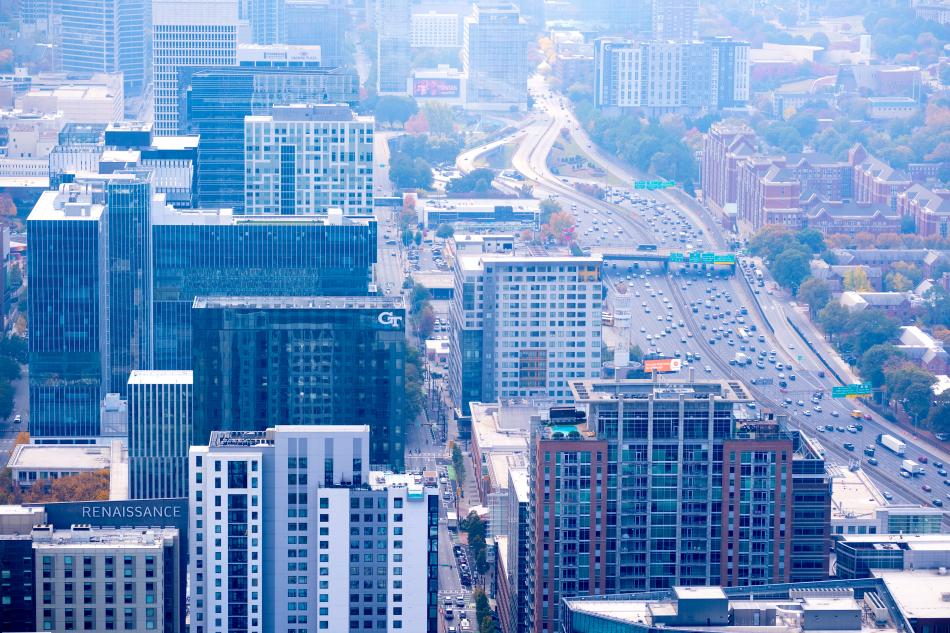 Vantage point from high floors at the 60-story skyscraper, where checking Connector traffic from living rooms will be possible. Courtesy of Rockefeller Group
Vantage point from high floors at the 60-story skyscraper, where checking Connector traffic from living rooms will be possible. Courtesy of Rockefeller Group
UA: One sentiment we’ve heard from developers lately is that—given turbulence in the market and interest rates and everything else—affordable housing in some cases just won’t pencil out, just isn’t possible. Rockefeller doesn’t have tunnel vision on Midtown; you’re looking at the metro and the state. But have you personally looked at developing maybe along the Beltline, or somewhere that would require affordable housing, and if so, does it seem like an impossible hurdle, even in a time when there’s such a crunch?
JP: We’ve looked in general. I think affordability in general is an issue, just related to the cost of delivering units at a rate that can meet the average household income of the submarket. And there’s clearly a gap. So I think, what tends to happen, you start looking at those opportunities where maybe the land cost might be lower. You get a little bit of an urban-sprawl desire, because you’re like, “Where can we build cheaper? Where can we build maybe a different format of construction?”
As you know, [1072 West Peachtree] is a cast-in-place, concrete tower. A very complex structure. And the cost per unit of this tower compared to a stick-built, suburban multifamily project is literally night and day. If we want to [target] a household income profile that can afford an apartment, we have to figure out how to kind of bend that cost curve for delivering that per-cost unit.
Construction costs have definitely tapered and modified over the last few years, so that feels better. Land costs are still up, and interest rates are still very high. So it’s still a sticky problem. It’s just math. And the math is hard to make work sometimes.
UA: When do you expect first move-ins in Midtown?
JP: We’re targeting summer of 2026. While we topped out, there’s now all the construction that’s going on inside those units.
UA: So it’s possible, or not, that people might actually be living there when the World Cup bonanza comes to Atlanta?
JP: I would like to think it’s possible, yes. Without a doubt.
...
Follow us on social media:
Twitter / Facebook/and now: Instagram
• Midtown news, discussion (Urbanize Atlanta)




